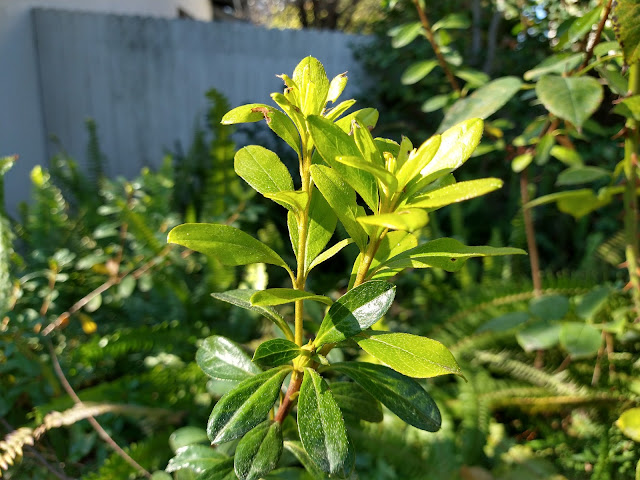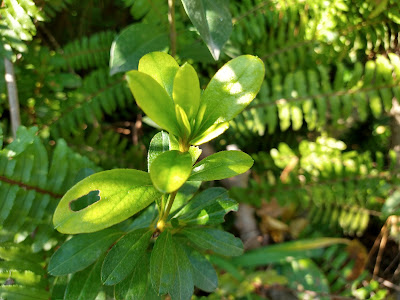
Waterlogged soil can lead to iron deficiency

|
| This azalea shows signs of chlorosis in its new growth. Waterlogged soil likely kept the plant from accessing iron in the soil. (Photos: Debbie Arrington) |
Are your azaleas looking a little peaked? It may not be a lack of nutrients, but too much water.
Cindy Nalepa-Nelson, an observant longtime gardener, noticed yellowish growth on azaleas in her Land Park garden. In a walk around her neighborhood, she spotted several other examples of azaleas that were showing telltale signs of chlorosis, or yellowing of normally green leaves.
Usually, this yellowing is a sign of iron deficiency. But that doesn’t mean there’s not enough iron in the soil. Due to soil conditions, the plant’s roots couldn’t access that iron when the bush needed it for green, chlorophyll-packed leaves.
Cindy wondered if the yellow leaves could be linked to recent rain, particularly December’s deluge. According to UC Cooperative Extension master gardeners, the heavy rain likely did play a role. But it didn’t leach out the iron; it waterlogged the soil.
“Azaleas, citrus, gardenias, rhododendrons, and other plants that are adapted to acidic soil are especially prone to iron deficiency when soil pH is above about 7.5 (alkaline),” say the master gardeners. “Iron deficiency is also common when soils are cool, high in calcium, poorly drained, or waterlogged.”

|
|
Here's another azalea with chlorosis. Notice the green veins
in the yellowish leaves.
|
Iron deficiencies tend to be more common in clay soils; the iron becomes “locked” in the soil and unavailable for plant roots.
Other signs of iron deficiency: Stunted or malformed new growth; mottled yellow leaves with green veins; and bud or fruit drop. Leaves may develop brown margins, too.
Because azaleas are shooting out new growth now, those yellowish leaves are more noticeable.
To remedy the problem, aerate the soil. Poke holes to encourage drainage. Add compost or other organic matter to help drainage as well as the soil’s acidity.
Then go ahead and feed those yellowish azaleas with chelated iron, a form of this nutrient that’s easily and quickly absorbed by plants – even in clay soils. Chelated iron is available at nurseries and home centers.
For more about iron deficiency in plants, check out these UC integrated pest management plant notes: http://ipm.ucanr.edu/PMG/GARDEN/PLANTS/DISORDERS/irondeficiency.html.
Comments
0 comments have been posted.Sacramento Digs Gardening to your inbox.
Food in My Back Yard Series
April 22: Should you stock up on fertilizer? (Yes!)
April 15: Grow culinary herbs in containers
April 8: When to plant summer vegetables
April 1: Don't be fooled by these garden myths
March 25: Fertilizer tips: How to 'feed' your vegetables for healthy growth
March 18: Time to give vegetable seedlings some more space
March 11: Ways to win the fight against weeds
March 4: Potatoes from the garden
Feb. 25: Plant a fruit tree now -- for later
Feb. 18: How to squeeze more food into less space
Feb. 11: When to plant? Consider staggering your transplants
Feb. 4: Starting in seed starting
Sites We Like
Garden Checklist for week of April 27
Once the clouds clear, get to work. Spring growth is in high gear.
* Set out tomato, pepper and eggplant transplants.
* From seed, plant beans, beets, cantaloupes, carrots, corn, cucumbers, melons, pumpkins, radishes and squash. Plant onion sets.
* In the flower garden, plant seeds for asters, cosmos, celosia, marigolds, salvia, sunflowers and zinnias. Transplant petunias, zinnias, geraniums and other summer bloomers.
* Plant perennials and dahlia tubers for summer bloom. Late April is about the last chance to plant summer bulbs, such as gladiolus and tuberous begonias.
* Transplant lettuce and cabbage seedlings.
* Weed, weed, weed! Don’t let unwanted plants go to seed.
* April is the last chance to plant citrus trees such as dwarf orange, lemon and kumquat. These trees also look good in landscaping and provide fresh fruit in winter.
* Feed citrus trees with a low dose of balanced fertilizer (such as 10-10-10) during bloom to help set fruit. Keep an eye out for ants.
* Apply slow-release fertilizer to the lawn.
* Thoroughly clean debris from the bottom of outdoor ponds or fountains.
* Start thinning fruit that's formed on apple and stone fruit trees -- you'll get larger fruit at harvest (and avoid limb breakage) if some is thinned now. The UC recommendation is to thin fruit when it is about 3/4 of an inch in diameter. Peaches and nectarines should be thinned to about 6 inches apart; smaller fruit such as plums and pluots can be about 4 inches apart. Apricots can be left at 3 inches apart. Apples and pears should be thinned to one fruit per cluster of flowers, 6 to 8 inches apart.
* Azaleas and camellias looking a little yellow? If leaves are turning yellow between the veins, give them a boost with chelated iron.
* Trim dead flowers but not leaves from spring-flowering bulbs such as daffodils and tulips. Those leaves gather energy to create next year's flowers. Also, give the bulbs a fertilizer boost after bloom.
* Pinch chrysanthemums back to 12 inches for fall flowers. Cut old stems to the ground.
* Mulch around plants to conserve moisture and control weeds.